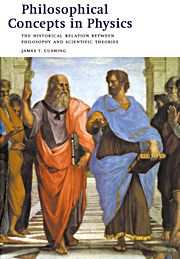 Philosophical Concepts in Physics
Philosophical Concepts in Physics Book contents
- Frontmatter
- Contents
- Preface
- Copyright acknowledgments
- PART I The scientific enterprise
- PART II Ancient and modern models of the universe
- PART III The Newtonian universe
- PART IV A perspective
- PART V Mechanical versus electrodynamical world views
- 13 Models of the aether
- 14 Maxwell's theory
- 15 The Kaufmann experiments
- PART VI The theory of relativity
- PART VII The quantum world and the completeness of quantum mechanics
- PART VIII Some philosophical lessons from quantum mechanics
- PART IX A retrospective
- Notes
- General references
- Bibliography
- Author index
- Subject index
13 - Models of the aether
Published online by Cambridge University Press: 05 June 2012
- Frontmatter
- Contents
- Preface
- Copyright acknowledgments
- PART I The scientific enterprise
- PART II Ancient and modern models of the universe
- PART III The Newtonian universe
- PART IV A perspective
- PART V Mechanical versus electrodynamical world views
- 13 Models of the aether
- 14 Maxwell's theory
- 15 The Kaufmann experiments
- PART VI The theory of relativity
- PART VII The quantum world and the completeness of quantum mechanics
- PART VIII Some philosophical lessons from quantum mechanics
- PART IX A retrospective
- Notes
- General references
- Bibliography
- Author index
- Subject index
Summary
We shall see in Chapter 14 that, with Maxwell's great work, A Treatise on Electricity and Magnetism (1873), our conception of an electromagnetic wave (of which ordinary light is but one example) became that of a wave consisting of electric (E) and magnetic (B) fields propagating along at the speed of light (c). However, most waves of which we have some immediate experience, such as water waves, sound waves in air and waves in a vibrating string, are transmitted through some material medium. The obvious question, then, is what is the nature of the medium that transmits optical and other electromagnetic effects. At first sight this may not appear to pose much of a problem when these effects are transmitted through a material medium such as air, water or a solid. But electromagnetic waves do propagate through what we usually term a vacuum, as between the sun and the earth. In this chapter we review the history of certain ideas concerning light and electromagnetism.
EMERGENCE OF THE OPTICAL AETHER
As we saw previously, Descartes believed that all space was a plenum, everywhere filled with matter so that there were no voids and could exist no vacuum. An aether permeated all of space. For him, interactions could take place only via pressure and impact; that is, through the tangible action of some intermediary agent or matter.
Information
- Type
- Chapter
- Information
- Philosophical Concepts in PhysicsThe Historical Relation between Philosophy and Scientific Theories, pp. 183 - 194Publisher: Cambridge University PressPrint publication year: 1998